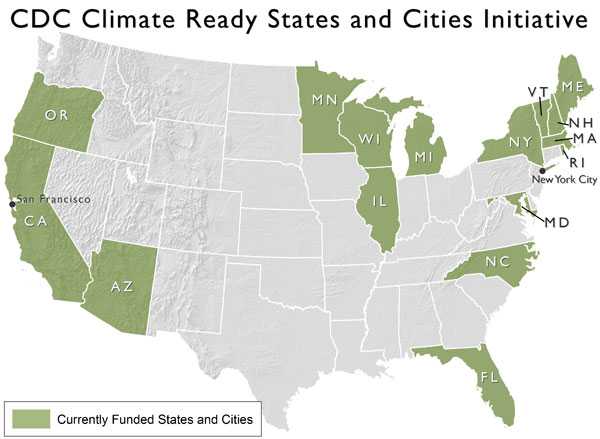Public Health Response to a Changing Climate
 Climate change threatens human health and well-being in many ways . Learn what CDC is doing to prevent and adapt to the health effects of climate change.
Climate change threatens human health and well-being in many ways . Learn what CDC is doing to prevent and adapt to the health effects of climate change.
The environmental consequences of climate change are happening now and are expected to increase in the future. Some of these changes will likely include:
- heat waves,
- heavy precipitation events and flooding,
- droughts,
- more intense hurricanes and storms,
- sea level rise, and
- air pollution.
Each of these impacts could negatively affect public health. While climate change is a global issue, the effects of climate change will vary across geographic regions and populations.
As the only HHS investment in climate change adaptation, CDC’s Climate and Health Program works to prevent and adapt to the possible health effects of climate change. The program identifies the populations most vulnerable to these impacts, predicts future trends, creates systems to detect and respond to emerging health threats, and designs programs to manage health risks now and in the future.
Through the Climate Ready States and Cities Initiative, the Climate and Health Program supports and funds 16 states and two cities that are using the Building Resilience Against Climate Effects (BRACE) framework to identify likely climate impacts in their communities, potential health effects associated with these impacts, and their most at-risk populations and locations. BRACE helps states develop and implement health adaptation plans that impact health and address gaps in critical public health functions and services.
Five sequential steps comprise the BRACE framework:
- Step 1: Anticipate Climate Impacts and Assessing Vulnerabilities
- Step 2: Project the Disease Burden
- Step 3: Assess Public Health Interventions
- Step 4: Develop and Implement a Climate and Health Adaptation Plan
- Step 5: Evaluate Impact and Improve Quality of Activities

CDC also funds a program that engages climate change observers in Alaska. Over the last several decades, Alaska has warmed twice as fast as the rest of the country. Dozens of Alaskan natives have become part of a sentinel surveillance system created by the Institute for Circumpolar Health Studies at the University of Alaska Anchorage. Observers document changes in weather, harvesting, and food and water safety. They also record health changes, such as shellfish poisoning caused by “red tide” algae blooms. In addition, Alaskan villagers are being trained to collect temperature and precipitation data in eight communities. In isolated villages, some effects of climate change may go unnoticed by the scientific world, but this study will hopefully fill in those gaps.
For more information on CDC’s Climate and Health Program, please visit our website.
- Page last reviewed: April 18, 2016
- Page last updated: April 18, 2016
- Content source:
- National Center for Environmental Health
- Page maintained by: Office of the Associate Director for Communication, Digital Media Branch, Division of Public Affairs




 ShareCompartir
ShareCompartir